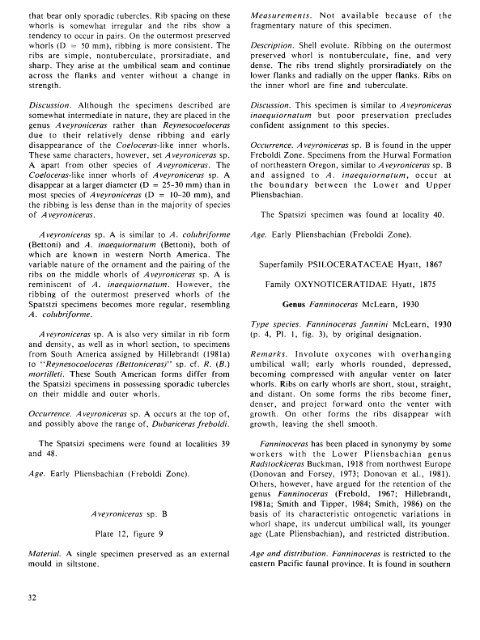PLIENSBACHIAN (LOWER JURASSIC) BIOSTRATIGRAPHY AND ...
PLIENSBACHIAN (LOWER JURASSIC) BIOSTRATIGRAPHY AND ...
PLIENSBACHIAN (LOWER JURASSIC) BIOSTRATIGRAPHY AND ...
You also want an ePaper? Increase the reach of your titles
YUMPU automatically turns print PDFs into web optimized ePapers that Google loves.
that bear only sporadic tubercles. Rib spacing on these<br />
whorls is somewhat irregular and the ribs show a<br />
tendency to occur in pairs. On the outermost preserved<br />
whorls (D = 50 mm), ribbing is more consistent. The<br />
ribs are simple, nontuberculate, prorsiradiate, and<br />
sharp. They arise at the umbilical seam and continue<br />
across the flanks and venter without a change in<br />
strength.<br />
D iscussion. Although the specimens described are<br />
somewhat intermediate in nature, they are placed in the<br />
genus Aveyroniceras rather than Reynesocoeloceras<br />
due to their relatively dense ribbing and early<br />
disappearance of the C oeloceras-like inner whorls.<br />
These same characters, however, set Aveyroniceras sp.<br />
A apart from other species of Aveyroniceras. The<br />
Coeloceras-like inner whorls of Aveyroniceras sp. A<br />
disappear at a larger diameter (D = 25-30 mm) than in<br />
most species of Aveyroniceras (D = 10-20 mm), and<br />
the ribbing is less dense than in the majority of species<br />
of Aveyroniceras.<br />
Aveyroniceras sp. A is similar to A . colubriform e<br />
(Bettoni) and A . inaequiornatum (Bettoni), both of<br />
which are known in western North America. The<br />
variable nature of the ornament and the pairing of the<br />
ribs on the middle whorls of Aveyroniceras sp. A is<br />
reminiscent of A . inaequiornatum . However, the<br />
ribbing of the outermost preserved whorls of the<br />
Spatstzi specimens becomes more regular, resembling<br />
A . colubriform e.<br />
Aveyroniceras sp. A is also very similar in rib form<br />
and density, as well as in whorl section, to specimens<br />
from South America assigned by Hillebrandt (1981a)<br />
to “ Reynesocoeloceras (Bettoniceras)” sp. cf. R. (B .)<br />
mortilleti. These South American forms differ from<br />
the Spatsizi specimens in possessing sporadic tubercles<br />
on their middle and outer whorls.<br />
Occurrence. Aveyroniceras sp. A occurs at the top of,<br />
and possibly above the range of, Dubariceras freboldi.<br />
The Spatsizi specimens were found at localities 39<br />
and 48.<br />
A ge. Early Pliensbachian (Freboldi Zone).<br />
A veyroniceras sp. B<br />
Plate 12, figure 9<br />
Material. A single specimen preserved as an external<br />
mould in siltstone.<br />
M e a su re m e n ts. Not available because of the<br />
fragmentary nature of this specimen.<br />
Description. Shell evolute. Ribbing on the outermost<br />
preserved whorl is nontuberculate, fine, and very<br />
dense. The ribs trend slightly prorsiradiately on the<br />
lower flanks and radially on the upper flanks. Ribs on<br />
the inner whorl are fine and tuberculate.<br />
Discussion. This specimen is similar to Aveyroniceras<br />
in a equiornatum but poor preservation precludes<br />
confident assignment to this species.<br />
Occurrence. Aveyroniceras sp. B is found in the upper<br />
Freboldi Zone. Specimens from the Hurwal Formation<br />
of northeastern Oregon, similar to A veyroniceras sp. B<br />
and assigned to A . in a e q u io r n a tu m , occur at<br />
the boundary between the Lower and U pper<br />
Pliensbachian.<br />
The Spatsizi specimen was found at locality 40.<br />
Age. Early Pliensbachian (Freboldi Zone).<br />
Superfamily PS1LOCERATACEAE Hyatt, 1867<br />
Family OXYNOTICERATIDAE Hyatt, 1875<br />
Genus Fanninoceras McLearn, 1930<br />
Type species. Fanninoceras fa n n in i McLearn, 1930<br />
(p. 4, PI. 1, fig. 3), by original designation.<br />
R e m a rk s. Involute oxycones with overhanging<br />
umbilical wall; early whorls rounded, depressed,<br />
becoming compressed with angular venter on later<br />
whorls. Ribs on early whorls are short, stout, straight,<br />
and distant. On some forms the ribs become finer,<br />
denser, and project forward onto the venter with<br />
growth. On other forms the ribs disappear with<br />
growth, leaving the shell smooth.<br />
Fanninoceras has been placed in synonymy by some<br />
workers with the Lower Pliensbachian genus<br />
Radstockiceras Buckman, 1918 from northwest Europe<br />
(Donovan and Forsey, 1973; Donovan et al., 1981).<br />
Others, however, have argued for the retention of the<br />
genus Fanninoceras (Frebold, 1967; Hillebrandt,<br />
1981a; Smith and Tipper, 1984; Smith, 1986) on the<br />
basis of its characteristic ontogenetic variations in<br />
whorl shape, its undercut umbilical wall, its younger<br />
age (Late Pliensbachian), and restricted distribution.<br />
A ge and distribution. Fanninoceras is restricted to the<br />
eastern Pacific faunal province. It is found in southern

















